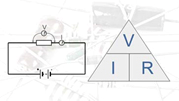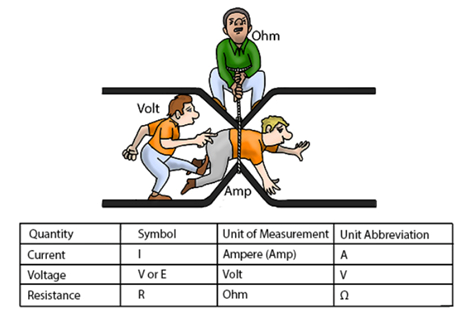What is Electronics?
Objectives - What is Electronics?
We use electronic devices every day, from cell phones to TVs, to many of our various tools and appliances. How often do we stop to consider what the field of electronics is? The word electronics is derived from the word electron, which is the source of electric charge. Electronics is the field of study focused on the control of electricity and the physical components and circuits that help direct electrical energy.
The world of IoT is based on several technologies, one of which is increasing availability of low-cost electronics sensors. A sensor is an electronic component that transforms a physical quantity, such as the temperature in the room, the position of a robotic arm, or the sugar level in the blood, into an electrical signal. The electrical signal that the sensor generates is then transformed into a digital signal to be processed by a very simplified computer system called a microcontroller. This chapter covers the basic understanding of how electronics is required to prototype an IoT solution.
Click here to view a list of different sensors (https://en.wikipedia.org/wiki/List_of_sensors )
If you wish to know how electronic devices control electric current you need to have a basic understanding of what electric current is.
Definitions
Electric current is constructed by the electron's’ movement. Current flows in a closed loop and is constant everywhere in the loop. Electrons along with protons and neutrons are what make up atoms. The basic charge on an electron is measured in terms of coulombs. One coulomb of charge is equal to the amount of charge carried by one ampere in one second.
Atoms are the building blocks of all elements and matter. Electrons carry negative charges and are attracted to the positively charged protons within the nucleus of the atom. Chemical elements on the periodic table are made up of different types of atoms. The gravitation between atoms and their outer electrons is stronger in some elements than in others.
Electrical conductors are materials with elements that have a weak attraction between atoms and their electrons. In conductive elements, electrons tend to move from atom to atom. Examples of electrically conductive materials are metals like copper, gold, and silver. Electrical insulators are materials made up of elements that strongly attract their electrons and in which the electrons never leave the atom. Examples of materials that are electrical insulators are dried wood, glass, and various rubber materials.
Voltage is the force that drives current. It can also be referred to as electric pressure. Voltage is measured as the difference in electric potential energy between two points.
Amperes (Amps) measure the strength of electric current. Amperes are a measure of the number of electrons in an electric current. One ampere per second is equivalent to one coulomb traveling through a circuit in one second. This is roughly equivalent to the flow of 6.241509×10^18 electrons per second.
Power is the amount of energy consumed over time. Power is measured in Watts. The basic formulation of power is power = voltage x current.
An electrical circuit is a physical network (or model of a physical network) of interconnected electrical components including batteries, resistors, capacitors, inductors, and switches.
Balls labeled P and N are clustered in the center of the page surrounded by 3 concentric circles. Each concentric circle has either 2 or three smaller balls labeled E.
Ohm’s Law
If your goal is to design, create, and analyze electrical circuits, then it is important to understand the relationship between voltage, current, and resistance within a circuit.
In the 1800s, George Ohm discovered that voltage is constantly proportional to current in a circuit with a fixed source of resistance. Ohm published his theory, which has become a fundamental concept in electronics, known as Ohm’s Law.
Ohm's Law is one of the most fundamental of laws for electrical theory. The Ohms Law formula or equation links voltage and current to the properties of the conductor, i.e. its resistance in a circuit.
According to Ohm’s Law, voltage is directly proportional to the strength of current multiplied by resistance within a circuit. Simply stated voltage equals current multiplied by resistance (V = I x R).
Ohm's Law is one of the most fundamental and important laws governing electrical and electronic circuits. It relates current, voltage and resistance for a linear device, such that if two are known, the third can be calculated easily.
With current, voltage and resistance being three of the major circuit quantities, this means that Ohm's Law is also immensely important.
Ohm's Law is used within all branches of electrical and electronic science. It is used for calculating the value of resistors required in circuits, and it can also be used for determining the current flowing in a circuit where the voltage can be measured easily across a known resistor, but more than this, Ohm's Law is used in a vast number of calculations in all forms of electrical and electronic circuit- in fact anywhere that current flows.

Ohm's Law discovery
There is a mathematical relationship which links current, voltage and resistance. A German scientist named Georg Ohm performed many experiments in an effort to show a link between the three. In the days when he was performing his experiments there were no meters as we know them today.
Only after considerable effort and at the second attempt did he manage to devise what we know today as Ohm's Law.
Note on Georg Ohm: Born in Erlangen, about 50 miles north of Munich in 1879, Georg Ohm went on to become one of the people who investigated much about the new science associated with electricity, discovering the relationship between voltage and current in a conductor - this law is now named Ohm's Law, honoring the work he did.
What exactly is Ohm's Law?
Ohm's Law describes the way current flows through a material when different levels of voltage are applied. Some materials like electrical wires present little resistance to the current flow and this type of material is called a conductor. Hence if this conductor is placed directly across a battery for example, a lot of current would flow.
In other examples another material may impede the flow of current, but still allow some though. In electrical circuits, these components are often called resistors. Yet other materials let virtually no current though and these materials are called insulators.
A triangle has a U inside the top of the triangle with a line under it. Under the U are the letters I and R with a vertical line between them. Three formulas are to the right of the triangle: R = U divided by I, I = U divided by R, U = I times R.

